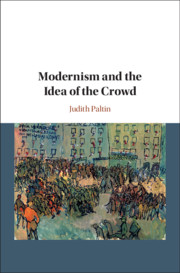Book contents
- Modernism and the Idea of the Crowd
- Modernism and the Idea of the Crowd
- Copyright page
- Contents
- Acknowledgments
- Introduction
- Chapter 1 Compositions of the Crowds of Modernism
- Chapter 2 Crowd Involvements and Attachments
- Chapter 3 Crowds and Transformation
- Chapter 4 Crowds and Agility
- Conclusion Assembly and the Agile Becoming-Subject
- Notes
- References
- Index
Chapter 3 - Crowds and Transformation
Published online by Cambridge University Press: 19 November 2020
- Modernism and the Idea of the Crowd
- Modernism and the Idea of the Crowd
- Copyright page
- Contents
- Acknowledgments
- Introduction
- Chapter 1 Compositions of the Crowds of Modernism
- Chapter 2 Crowd Involvements and Attachments
- Chapter 3 Crowds and Transformation
- Chapter 4 Crowds and Agility
- Conclusion Assembly and the Agile Becoming-Subject
- Notes
- References
- Index
Summary
Chapter Three, “Crowds and Transformation,” synthesizes concepts of self-recovery, play, and collective intellect to explore what transformative tools and practices crowds were developing (in modernist fictional worlds) in order to identify and represent themselves, or to have as tactical weapons during their conflicts with elite authority. Conventional identity is creatively reworked by disarticulated performances such as Clarissa’s or the unnamed Captain in The Secret Sharer. The chapter maps mechanisms that produce modernity’s porous and transmissible social mind, exemplified in readings of Jacob’s Room and “Ithaca,” for example. Historical examples of street demonstrations and popular movements in the first decades of the twentieth century in England and Ireland are compared with readings of the permeable and suggestible crowds of “Wandering Rocks” and Wyndham Lewis’ writings, to differentiate what the book identifies as rising crowds from Lewis’ crowds of “extinction.” Finally, the chapter transitions to the concept of crowdedness as an ethical experience.
Keywords
- Type
- Chapter
- Information
- Modernism and the Idea of the Crowd , pp. 83 - 125Publisher: Cambridge University PressPrint publication year: 2020

